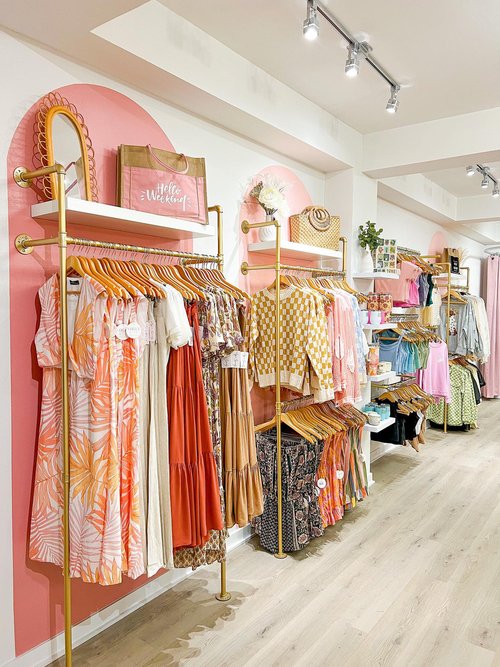A Beginner's Guide to Browsing the Boutique Fashion Scene
A Beginner's Guide to Browsing the Boutique Fashion Scene
Blog Article
Lasting Fashion: How Eco-Friendly Garments Is Forming the Future of Design
As the apparel industry encounters raising scrutiny over its ecological influence, the increase of sustainable fashion provides an encouraging choice that aligns style with ecological duty. Using ingenious materials such as plant-based materials and recycled fibers, along with sophisticated techniques like electronic and 3D printing, designers are redefining what it means to be stylish in the modern age. Concurrently, the expanding popularity of upcycling and thrift society is fostering a shift towards a round economic climate. Yet, how does this activity truly affect the future trajectory of style, and what obstacles lie in advance in its prevalent adoption?
Cutting-edge Lasting Products
As the style sector grapples with its environmental impact, innovative sustainable products have actually arised as a vital option for decreasing environmental footprints. These products not only lower dependence on fossil gas however likewise minimize harmful pesticide use and water usage.
Along with plant-based materials, innovations in biofabrication have actually caused the development of lab-grown fabrics. Mycelium natural leather, originated from mushroom roots, presents a functional and eco-friendly alternative to animal natural leather. Its production causes considerably lower carbon exhausts and water usage, making it a more lasting choice for stylist looking for to line up with environment-friendly techniques.
Recycled products are also acquiring grip, with polyester made from recycled plastic containers standing for a considerable advancement. This technology not only diverts plastic waste from seas and landfills but additionally decreases power intake compared to generating virgin polyester. With each other, these products underscore the potential for a more lasting garment industry, leading the way for ecologically mindful layout and manufacturing.
Eco-Conscious Production
Building on the technologies in sustainable products, the garment industry is also re-evaluating its production processes to further decrease environmental effect. Key techniques consist of minimizing water usage, lowering carbon exhausts, and eliminating hazardous chemicals. By taking on closed-loop systems, suppliers aim to recycle water and power efficiently, considerably decreasing waste. The assimilation of renewable resource resources, such as solar and wind power, right into production facilities additionally cuts dependence on fossil fuels.
Another vital element is the decrease of harmful chemicals typically used in dyeing and completing textiles. Eco-conscious manufacturers are changing towards plant-based dyes and waterless dyeing modern technologies, which not only safeguard local communities but likewise boost employee security. Developments like digital printing lower material waste and power consumption, supplying a cleaner choice to conventional approaches.
With the improvement of blockchain technology, business can now supply thorough understandings right into their supply chains, making certain ecologically pleasant and ethical methods at each step. As the need for eco-conscious products grows, producers are compelled to introduce, ensuring that the future of fashion is both elegant and lasting.
The Rise of Upcycling
Upcycling, a transformative method in sustainable fashion, involves artistically repurposing thrown out materials into new, top notch products. This ingenious strategy not just decreases waste but likewise decreases the demand for resources, thereby reducing the ecological effect more of garments manufacturing. By reimagining and reconstructing existing items, designers and fashion brands have the ability to instill originality right into their collections while promoting ecological responsibility.

In addition, the upcycling motion has empowered small companies and independent developers, that often lead in innovation because of their agility and creative thinking. By maximizing the bountiful accessibility of unused materials, these entities contribute to a round economic climate, showing that style can be both lasting and trendy. Through upcycling, the industry takes substantial strides in the direction of a much more responsible and conscious future.
Thrift Culture's Impact
The burgeoning thrift culture significantly improves the landscape of sustainable fashion, highlighting the relevance of mindful consumption. This cultural shift urges customers to accept previously owned garments, thus decreasing the demand for new garment manufacturing and minimizing ecological influence. Thrift shopping not only prolongs the lifecycle of clothes but additionally reduces the carbon impact connected with production, moving, and getting rid of garments.
A vital facet of thrift culture is its democratization of style. By providing a broad array of styles from numerous ages at affordable prices, thrift shops make fashion easily accessible to a wider audience. This accessibility promotes a sense of individuality and creativity, as customers mix and match distinct items to curate customized closets without adding to the fast style cycle.
Additionally, second hand culture promotes circularity in style, lining up with the principles of a round economic climate. As Find Out More more consumers and developers accept second hand society, the fashion industry is forced to adjust, incorporating sustainable techniques to satisfy the expanding demand for eco-conscious choices.

Future Trends in Style
Fashion's evolution is increasingly shaped by sustainability-driven efforts and technical innovations. One famous pattern is the rise of digital style, where virtual garments can be worn in increased fact atmospheres, considerably lowering fabric waste.
Additionally, the integration of blockchain modern technology uses brand-new opportunities in openness and traceability, enabling customers to confirm the sustainability qualifications of their clothing. boutique fashion. This makes sure liability in supply chains and advertises honest sourcing methods. 3D printing is yet another technology that promises to change manufacturing processes by making it possible for on-demand production, thus decreasing excess inventory and waste
In addition, the development of bio-fabricated products, such as lab-grown leather and plant-based fabrics, presents sustainable choices to typical products. These technologies decrease reliance on pet items and resource-intensive crops. As these modern technologies mature, they are poised to transform the style landscape, merging design with sustainability. The future of style, as a result, hinges on a smooth blend of modern technology, technology, and eco-friendly duty.
Final Thought
The change of the garment industry via lasting practices indicates a pivotal change towards ecological liability. The combination of ingenious products, eco-conscious production techniques, and the embracement of upcycling and second hand culture emphasizes a commitment to minimizing eco-friendly impacts. As these methods gain energy, they redefine the market's story by prioritizing sustainable and honest options. This development not just lines up style with ecological sustainability however likewise establishes a precedent for future fads focused on responsibility and technology.
As the fashion sector encounters increasing scrutiny over its ecological influence, the increase of sustainable style supplies a promising choice that straightens style with environmental responsibility.As the fashion industry grapples with its environmental influence, innovative lasting materials have emerged as a critical option for decreasing ecological impacts. With each other, these products highlight the potential for an extra sustainable style industry, paving the means for eco conscious style and production.
Structure on the innovations in lasting materials, the fashion market is additionally re-evaluating its manufacturing procedures to additionally reduce ecological impact. boutique fashion.Upcycling, a transformative practice in sustainable fashion, entails creatively repurposing discarded materials right into brand-new, top notch products
Report this page